Physical Address
304 North Cardinal St.
Dorchester Center, MA 02124
The squamous columnar junction (SCJ) is defined as the border between stratified squamous epithelium of the exocervix and glandular epithelium of the endocervix. The SCJ is constantly subjected to hormonal influences, and as a consequence, its anatomic location varies with age. At birth, the portio of most female neonates is lined by endocervical epithelium because of intrauterine exposure to maternal hormones, but it rapidly moves back into the endocervical canal until menarche. During puberty, pregnancy, or progesterone therapy, endocervical glandular epithelium involving the exocervix results in what is clinically known as physiologic cervical eversion or ectropion ( Fig. 8.1 ), which appears as a red, velvety zone surrounding the external os. Throughout reproductive years, endocervical epithelium is continuously replaced by metaplastic squamous epithelium due to exposure of the ectropion to the acidity of the vagina and other environmental factors; the degree of ectropion decreases with increasing age and time from onset of sexual activity. The “transformation zone” is the remodeled area of ectropion that undergoes active squamous metaplasia and represents the region between the original and functional SCJ. During menopause, the transformation zone recedes into the endocervical canal, and in postmenopausal women may be located completely within the endocervical canal. Remodeling of the ectropion does not occur uniformly; in fact, squamous metaplasia often occurs anywhere within the exposed endocervical columnar epithelium in a patchy fashion. The transformation zone is the anatomic origin of over 90% of cervical carcinomas and high-grade intraepithelial lesions. Indeed, recent studies have documented a population of CK7+ nonstratified cuboidal cells at the SCJ, which retains capability of further differentiation and gives rise to squamous metaplasia. This “reserve cell” population, when infected with human papillomavirus (HPV), is the likely cell of origin of cervical cancer and its precursors.
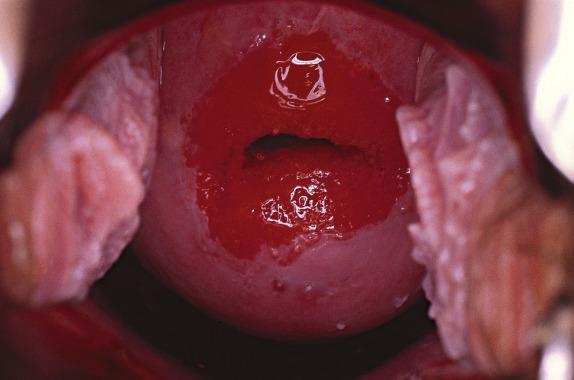
It is well established that HPV infection plays an essential role in the development of precancers and cancers of the cervix, as virtually all squamous cell carcinomas and ∼80%–90% of endocervical adenocarcinomas are positive for HPV. HPV is a double-stranded DNA virus and member of the Papovaviridae family. Genital HPVs constitute a group of more than 40 related viruses with predilection for the skin and squamous mucosa. The different subtypes of HPV are divided into “low-risk” and “high-risk” groups depending on the associated risk of carcinoma. Low-risk subtypes include 6, 11, 42, 43, 44, and 53, whereas high-risk subtypes are 16, 18, 31, 33, 35, 39, 45, 51, 52, 56, 58, 59, and 68. HPV types 16 and 18 account for 70% of all cervical carcinomas. HPV 16, 18 and 45 are present in more than 80% of adenocarcinomas, whereas squamous cell carcinoma is associated with a wider diversity of high-risk HPV subtypes. There are regional and geographic differences in the prevalence of certain HPV types with more developed countries having a higher rate of infection by HPV types 16 and 18 than less developed countries.
The human papillomavirus enters the aforementioned embryonic cells at the SCJ, basal cells or immature squamous metaplastic cells through defects in the mucosa at the transformation zone. The virus can cause either a nonproductive (latent) or productive infection. In the latter, large amounts of free DNA virus (episomal) are produced in the intermediate and superficial cell layers, which are nonproliferating terminally differentiated squamous cells. As the virally infected cells mature and migrate towards the surface, the characteristic cytopathic effect—so-called koilocytic atypia—becomes apparent.
Integration of HPV DNA into the host cell genome, with covalent binding of the viral genome into host DNA, is thought to be a critical event in cervical carcinogenesis. High-risk HPVs produce E6 and E7, two proteins with growth-stimulating and transforming properties. Viral integration into the host cell genome results in overexpression of E6/E7 genes. Excessive levels of E6/E7 viral oncoproteins result in abrogation of p53/Rb tumor suppressor proteins, with resultant uncontrolled cell cycling and proliferative activity of the epithelium. Low-risk types (HPV 6, 11) do not integrate into the host genome and cause low-grade squamous intraepithelial lesions: these types are responsible for 90% of exophytic condylomas (more common in the vulva) and 10% of low-grade squamous intraepithelial lesions (so-called “flat condylomas”). Conversely, high risk types 16 and 18 account for 25% of low-grade lesions, 50%–60% of high-grade lesions and 70% of cervical cancers. The remainder of both low and high-grade lesions are associated with other high-risk HPV types.
A recent multicenter study (“Atypical squamous cells/Low grade squamous intraepithelial lesion Triage Study [ALTS]”) showed that 83% of women with a low-grade squamous intraepithelial lesion (LSIL) on Papanicolaou test had a high-risk HPV subtype, although the risk of LSIL progressing to carcinoma is only ∼1%, even with persistent or recurrent infections. For instance, a new high-grade squamous intraepithelial lesion (HSIL) after a previous diagnosis of LSIL could represent a new emerging infection rather than progression. Moreover, occasional squamous intraepithelial lesions that display abrupt transitions from low- to high-grade morphology have been shown to be due to coinfection by different HPV types in different parts of the lesion. Indeed, it is not uncommon to have multiple HPV infections at the same time. There is no evidence that having multiple infections puts a patient at increased risk of progression to carcinoma.
In developed countries, widespread cytology screening programs have allowed detection and treatment of high-grade lesions before they progress to cancer. Half of all cervical cancers currently diagnosed in the United States arise in women who have never been screened, and 10% occur in women who have not been screened in the previous 5 years. There is currently one HPV DNA assay approved by the Food and Drug Administration (FDA) for women 25 and older that can be used as a primary screening tool to assess the need for additional testing. The cobas HPV test detects DNA from 14 high-risk HPV types. It specifically identifies HPV 16 and 18 while concurrently detecting 12 other high-risk types (non-16/18). The test can be used as a primary screening tool or in conjunction with Papanicolaou test.
The major new development in the prevention of cervical cancer is the HPV vaccine, which provides primary prevention of high-grade intraepithelial lesions and invasive carcinoma. Three different FDA approved vaccines are currently available in the United States targeting different HPV types: Gardasil is a quadrivalent vaccine targeting HPV 6, 11, 16, 18; Gardasil 9 is a 9-valent vaccine targeting 5 additional HPV types, 31, 33, 45, 52, and 58; Cervarix is a bivalent vaccine targeting HPV 16 and 18. The United States Advisory Committee on Immunization Practices (ACIP) first recommended the bivalent, quadrivalent or 9-valent HPV vaccine for females aged 11–12 and the 9-valent vaccine for males aged 11–12. Inclusion of adolescents and adults in the recommendations is currently in progress, as growing literature demonstrates benefit in these populations as well.
This method allows examination of the cervix with a colposcope, a binocular instrument with a magnification up to 40×. The entire transformation zone can easily be examined in women of reproductive age, both before and after 5% acetic acid is applied to the surface of the cervix. In postmenopausal women, the transformation zone may be located completely within the endocervical canal, which often results in an unsatisfactory or indeterminate colposcopic examination ( Fig. 8.2 ). Abnormal colposcopic findings include acetowhite epithelium (squamous epithelium that becomes white after acetic acid application), leukoplakia, punctation, mosaicism, and abnormal vessels. Any of these abnormalities almost always leads to cytology and/or cervical biopsy sampling.
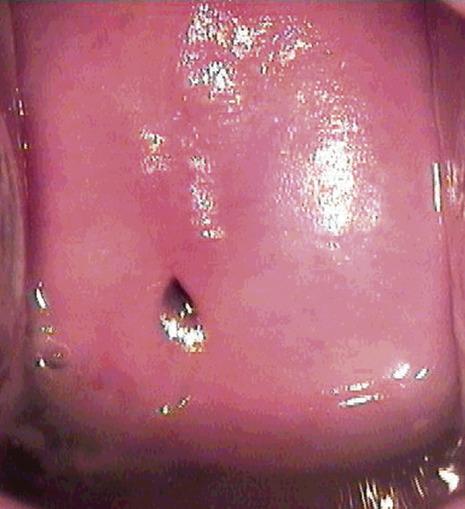
In 2012, the Lower Anogenital Squamous Terminology (LAST) project of the College of American Pathology and the American Society for Colposcopy and Cervical Pathology proposed a single nomenclature system for HPV-associated squamous lesions in all anatomic locations of the anogenital tract. The LAST recommends the two-tier Bethesda system, classifying both histologic and cytologic lesions as low-grade (LSIL) or high-grade (HSIL) . The previously used “cervical intraepithelial neoplasia” terminology was harmonized with this system: LSIL (CIN 1) and HSIL (CIN 2 or CIN 3). The Bethesda classification was chosen as it more closely reflects the biology of cervical cancer precursor lesions with LSILs representing self-limited, productive, transient viral infections and HSILs representing precancerous lesions with potential to progress to invasive carcinoma. It also unifies the nomenclature used for reporting both cervical cytology and biopsy specimens, resulting in less confusion amongst clinicians, pathologists, and patients. Furthermore, the category of CIN 2 has poor reproducibility and is likely a mix of lesions that are either CIN 1 or CIN 3. Because the treatment of women younger than 26 years with HSIL still depends on categorization as CIN2 (observation) or CIN3 (excision), the LAST recommends further classification of HSIL as CIN2 or CIN3, at least in this age group. There are no ancillary tests that can adjudicate CIN 2 versus 3.
This category includes CIN I, which is a flat lesion and exophytic lesions (condyloma acuminatum). These lesions are the result of productive HPV infections in which large numbers of viral particles are generated and produce visible alterations in the squamous epithelium, which tend to resolve spontaneously.
Exophytic condyloma is a benign genital wart caused by low-risk HPV, most commonly types 6 and 11. There is no risk for progression to invasive carcinoma and it should be treated as an isolated infection. Nonetheless, they are usually excised to exclude a neoplasm. In contrast to the vulva, where condylomata are relatively common, exophytic condyloma of the cervix is very uncommon.
LSIL/CIN 1 (so-called “flat condyloma”) displays koilocytic atypia in flat epithelium, without a warty macroscopic or clinical appearance. As mentioned previously, these lesions can be caused by low- and high-risk HPV types, unlike exophytic condyloma. As the distinction between “condyloma” (caused by low-risk HPV) from CIN 1 (caused by high-risk HPV) is not only impossible on pathologic examination but also clinically immaterial, the entire spectrum of flat low-grade lesions is now subsumed within the LSIL category.
Low-grade squamous intraepithelial lesions typically occur in reproductive age women, with a peak incidence in the third decade, as most young women are exposed to HPV sometime after becoming sexually active. The incidence decreases with age; <0.1% of postmenopausal women have LSIL on a Papanicolaou test. While the true prevalence of squamous intraepithelial lesions is not known, a large study conducted by the College of American Pathologists (CAP) in 1997, including 300 US laboratories, showed that only 1.97% and 0.5% of 16,132 Papanicolaou tests were diagnosed as LSIL and HSIL, respectively. Most women will develop transient infections that regress spontaneously. HIV infected women are seven times more likely to develop squamous intraepithelial lesions involving the lower genital tract compared to non-HIV-infected women. In addition, typical condyloma acuminata tend to recur and grow in size and number in otherwise healthy, non-HIV-infected pregnant women, but typically regress during postpartum.
These lesions may be seen as white plaques (leukoplakia) or acetowhite lesions after the administration of 5% acetic acid ( Fig. 8.3 ). Nonetheless, these colposcopic changes are not specific for LSIL, as squamous metaplasia, inflammatory/reactive changes, and HSILs may have a similar appearance. The rare condyloma acuminatum may be seen under colposcopic exam as a raised polypoid or papillary lesion with prominent vasculature; uncommonly, the lesion can be quite large (>2 cm) raising concern for malignancy. LSIL can occur anywhere in the transformation zone, tend to be smaller than HSIL, and only infrequently involve the endocervical canal.
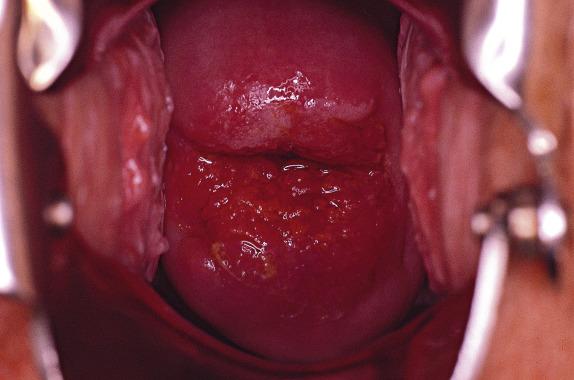
The majority of LSILs are not apparent on gross examination; however, some may be identified as white irregular plaques (leukoplakia). Condyloma acuminatum can appear as a gray-white and exophytic lesion.
On low-power examination, the very rare exophytic condyloma shows distinctive architectural changes, including epithelial hyperplasia (acanthosis) and papillomatosis ( Fig. 8.4A ). Often atypical parakeratosis and hyperkeratosis are present. Koilocytosis (described later in the text) is evident in superficial epithelial layers, at least focally. Nonetheless, incipient or regressing lesions may have a vaguely undulating appearance and absent or only subtle koilocytosis. Productive viral infection can be demonstrated with HPV in situ hybridization highlighting complete effacement of the nucleus with viral particles ( Fig. 8.4B ).
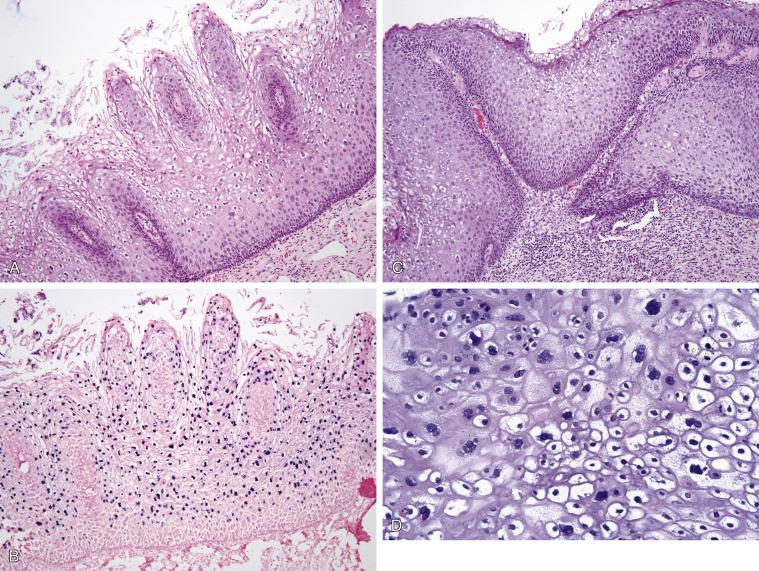
Flat forms of LSIL, by far more common, lack the papillomatosis of condyloma but may show acanthosis with variable degree of increased cellular density and disorganization at or near the surface ( Fig. 8.4C ). Cytologic alterations associated with HPV infection affect both the cytoplasm and nucleus. Cytoplasmic changes include irregular perinuclear clearing with condensation of the cytoplasm at the periphery of the cell. Nuclear changes include enlargement, nuclear membrane irregularities (“raisinoid” appearance), coarse chromatin, hyperchromasia, and multinucleation. The most important feature is nuclear enlargement in the superficial squamous cells as it represents expansion of the nucleus by fully formed viral particles at the end of their replication cycle in the host cell. These cytologic features are pathognomonic of HPV infection and are collectively termed “koilocytic atypia” or “koilocytic change” ( Fig. 8.4D ), though these are not considered diagnostic terms and should not be used as final diagnoses in a pathology report. Of note, a prominent nucleolus is not a feature of either LSIL or HSIL. There may be few or no mitotic figures, and if present, they are normal in appearance and located in the basal/parabasal layers. Importantly, the pattern of epithelial squamous maturation is retained , with a uniform and well-organized basal layer and normal progressive flattening and accumulation of eosinophilic cytoplasm towards the surface. Approximately 50% of LSILs show band-like staining of the lower one-third of the epithelium with p16 and all show at least focal aggregates of squamous cell nuclear staining with Ki-67 (mib-1) in the upper 1/2 of the epithelium.
Several studies, most recently including the multicenter ALTS trial, have shown high interobserver variability in the diagnosis of LSIL. Moreover, the architectural changes in LSIL can be subtle. Thus, the diagnosis of LSIL must rely on the unequivocal presence of koilocytosis, as described previously. This is important because most mimickers may display some features attributed to LSIL. For instance, mature glycogenated squamous epithelium characteristically has cytoplasmic halos and hyperchromatic nuclei; attention to the typical basket-weave architecture, the regular contour of the halos and the pyknotic nature of the nuclei (hyperchromatic, but small and uniform) will correctly exclude LSIL. Likewise, prominent cytoplasmic perinuclear clearing alone without the characteristic virally induced nuclear changes is nonspecific and can be seen in atrophy, infections (such as trichomoniasis, candidiasis, and bacterial vaginosis), and reactive squamous epithelium. Postmenopausal squamous atypia may be confused with koilocytic atypia because of the finding of cytoplasmic halos, some degree of nuclear enlargement, hyperchromasia, and occasional binucleated cells. However, in contrast to LSIL, the nuclei are evenly spaced, the nuclear membranes are smooth, and the cytoplasmic halos have uniform contours.
Squamous metaplasia associated with reactive changes may exhibit incomplete maturation, enlarged nuclei, binucleated cells, and scattered mitotic activity mainly in the basal layers. However, the cells appear monomorphic, the nuclei are not crowded and have smooth nuclear contours, a uniform, relatively hypodense chromatin distribution and recognizable nucleoli. Moreover, cytoplasmic halos are round and regular in shape.
High-grade squamous intraepithelial lesion may be difficult to distinguish from LSIL, especially in thin epithelium. LSIL typically shows retained cell maturation in the upper two-thirds of the epithelium and koilocytic change within the superficial cell layers. Only minimal nuclear atypia is present in the lower one-third of the epithelium, which is mostly uniform and well polarized. If any of the following features is present, HSIL should be strongly considered: marked nuclear enlargement (>3 × size of parabasal cell) with loss of organization in basal layers and upper layers, abnormal mitoses, mitoses in the superficial half of the epithelium, or extreme multinucleation (≥5 nuclei in a single cell). p16 immunohistochemistry has limited value, as a subset of LSILs can show p16 overexpression. Nonetheless, a negative of patchy p16 staining pattern will be in keeping with LSIL.
It is important to keep in mind that the majority of LSIL will regress within 1 year, and only approximately 15% will persist and only very rarely progress to HSIL. The management of LSIL is dependent on the patient’s age and the results of HPV co-testing, if applicable. If the woman is under age 25, repeat cytologic examination at 1 year is preferred, as the vast majority of low-grade lesions will resolve during this time period in this age group. Cytology plus HPV testing is the preferred screening modality in women over the age of 30. Colposcopy is recommended if both tests are positive, while repeat dual testing at 1 year is recommended if the HPV test is negative. If colposcopy is performed, the cervix is thoroughly evaluated, and any suspicious areas are biopsied. If the biopsy shows LSIL or is negative and correlated with the colposcopic findings, the patient is followed and co-tested at 12 months. If, however, the colposcopic examination is indeterminate or reveals a lesion more worrisome than the biopsy findings, treatment of the entire transformation zone may be necessary.
Squamous intraepithelial lesion associated with both low- and high-risk HPV subtypes
Includes “flat” (CIN I) and exophytic lesions (condyloma acuminatum)
Unknown true prevalence; however, up to 3.0% of Papanicolaou smears reported as SIL
Transformation zone (most commonly)
Reproductive age women
No race predilection, but greater frequency in whites than blacks, possibly reflecting screening differences
Peak incidence in mid-20s, decreasing thereafter (approximately 5% of women ≤30 years have LSIL on Papanicolaou smear, vs. <0.1% of women ≥65 years)
Asymptomatic
Leukoplakia or acetowhite epithelium
Papillary lesion with prominent vasculature (condyloma acuminatum)
Only 15% of LSIL progress to HSIL
In women under 25, repeat cytology in 12 months
In women over 30, dual cytology and HPV testing; colposcopy if both positive
If colposcopy and biopsy confirm LSIL, follow-up with dual testing in 12 months
If biopsy is discordant, additional sampling may be necessary
White irregular plaques (leukoplakia) may sometimes be seen
Tan-white raised papillary lesion (condyloma acuminatum)
Koilocytic atypia (nuclear enlargement, nuclear membrane irregularities, coarse chromatin, hyperchromasia, multinucleation, and peripheral cytoplasm condensation) in superficial layers
Mature glycogenated squamous epithelium
Postmenopausal squamous atypia
Metaplastic squamous epithelium with reactive changes
High-grade squamous intraepithelial lesion
Cervical high-grade squamous intraepithelial lesions are relatively frequent with an estimated incidence of up to 31 per 100,000 women, without racial differences. Approximately 0.8% of Papanicolaou smears are reported as HSIL. These lesions are seen in a slightly older age group than LSIL, with the highest prevalence in women between 35–39 years. However, over the past 20 years, the frequency of HSIL has increased in younger women, in part due to changing sexual habits. The lesions are usually clinically asymptomatic.
In addition to acetowhite epithelium and leukoplakia, additional colposcopic abnormalities include “mosaicism” and “punctations” ( Fig. 8.5 ). Although these changes are occasionally seen in LSIL, they are more prominent in HSIL. The mosaic pattern is a result of anastomosing vessels branching through portions of epithelium and displaying a basket-like pattern. Punctations are created by vessels, which form a hairpin turn as they approach the surface and then return to the underlying stroma. The colposcopic findings will have a worrisome appearance when vessels are situated further apart and punctations are coarser.
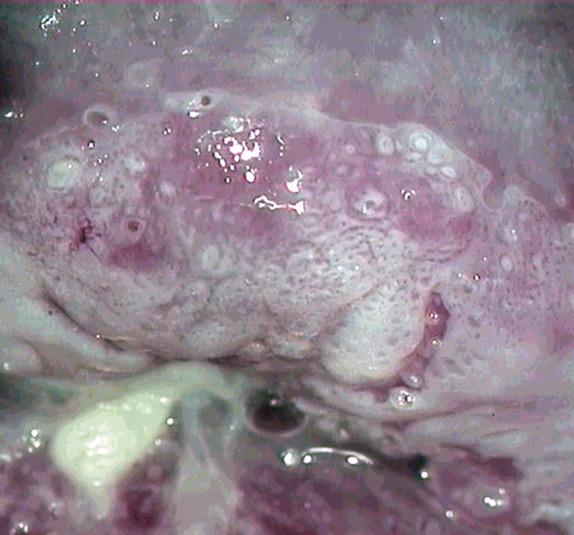
Other than the colposcopic findings described above, the changes associated with HSIL usually cannot be visualized on gross examination. Occasionally, HSIL may be seen as an area of leukoplakia.
On low-power examination, HSIL demonstrates loss of maturation with increased nuclear density and nuclear atypia involving both the upper and lower epithelial layers. The dysplastic cells frequently show syncytial growth with no distinct intercellular borders, secondary to crowding and loss of polarity in the basal and parabasal layers. The atypical cells appear immature, with high nuclear-to-cytoplasmic (N/C) ratio, irregular nuclear membranes, coarse and irregularly distributed chromatin, and inconspicuous nucleoli. Mitoses typically involve the upper half of the epithelium, and abnormal mitotic figures may be present. Although most HSILs show variation in nuclear size, in some cases the nuclei are quite uniform. However, they still exhibit crowding, lack of organization and maturation, high N/C ratio, hyperchromasia, and increased mitotic activity.
Sometimes, HSIL arises in metaplastic squamous epithelium or acquires an immature metaplastic appearance. These scenarios have been described in the literature as “atypical immature squamous metaplasia” or “immature metaplastic HSIL”. In these instances, cells have more abundant cytoplasm and nuclear atypia is subtle. However, there is still loss of organization and polarity in the basal cell layers, hyperchromasia, and coarse chromatin.
CIN 2 and 3 are (subjectively) distinguished from one another by the degree of discernible cell maturation. In CIN 2, immature cells occupy the lower two-thirds of the epithelium but some degree of maturation or koilocytic atypia is present towards the surface ( Fig. 8.6A ). In CIN 3, there is complete or near-complete loss of maturation, as immature cells occupy the full-thickness epithelium, often associated with a layer of atypical parakeratotic cells on the surface. Mitoses can be seen at all levels of the epithelium, as can marked nuclear pleomorphism ( Fig. 8.6B,C ). Though CIN 2 and CIN 3 are both considered in the HSIL category, distinction is still made in adolescents and young women since their management may be different. HSIL coexists with LSIL in approximately 15% of cases, and not infrequently involves the endocervical glands, which may result in complete or partial luminal obliteration ( Figs. 8.7 and 8.8 ). A “thin” variant of HSIL has been described, defined as having ≤9 cells of thickness.
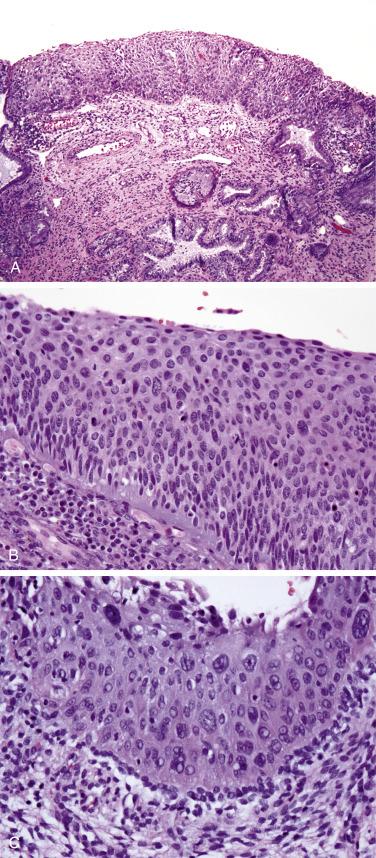
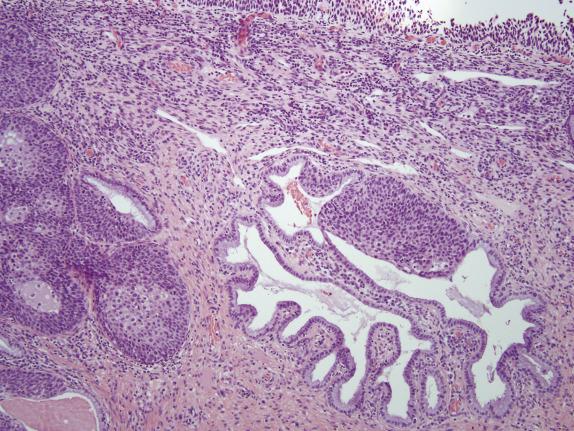
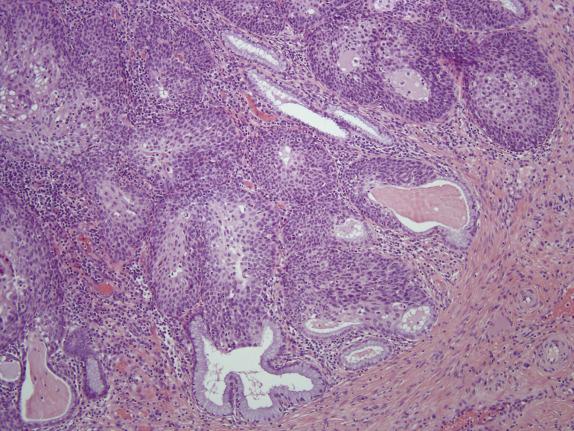
p16 protein, a surrogate marker for HPV infection, is overexpressed in cervical cancers and precursor lesions associated with high-risk HPV subtypes. p16 promotes synthesis of the retinoblastoma protein (Rb), which in turn binds to the transcriptional factor E2F thus stopping cell cycle progression. The HPV oncoprotein E7 binds competitively to Rb, inactivating it and therefore increasing free E2F leading to cell cycle progression. E2F accumulation also disrupts the negative feedback loop for p16, which consequently accumulates within the cell. p16 overexpression is strictly defined as continuous, strong, cytoplasmic and nuclear staining in the abnormal cells, which results in a “block” pattern of positivity. In HSIL, expression should involve at least the lower third of squamous epithelium, although it is usual to see block staining in two-thirds or full thickness of the epithelium. Importantly, this overexpressed pattern can also be seen in LSIL. ( Fig. 8.9 ). Ki-67 (MIB-1) immunoreactivity is present in the nuclei of the upper two-thirds of the epithelium in HSIL and LSIL, though there tends to be more labeling in HSIL. ( Fig. 8.10 ). CK7 is a marker of the “reserve” SCJ epithelium, from which most HSILs and carcinomas are thought to arise.
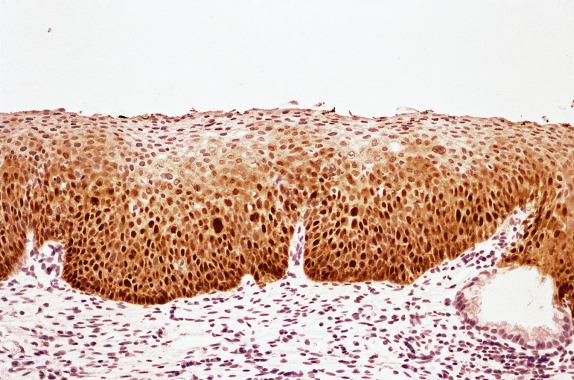
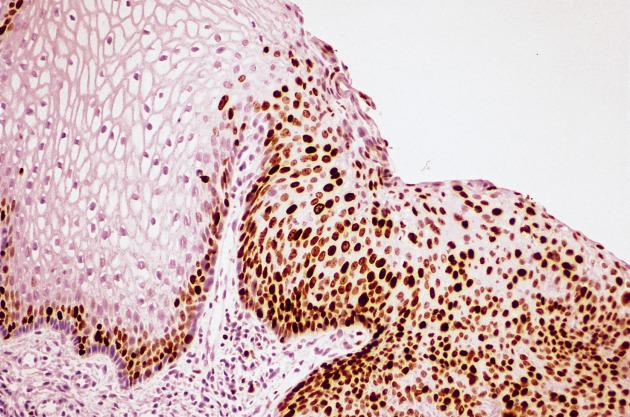
In atypia of repair , the squamous epithelium may be disorganized, atypical basal-like cells may be present up to the midzone, and there may be mild nuclear atypia and enlargement causing confusion with HSIL. In contrast to HSIL, repair should display some maturation of the squamous epithelium towards the surface and an overall retained organization of the basal layer, with cells having well-defined cell borders, no crowding, and no variation in cell size or shape. There are prominent nucleoli but no coarse chromatin, and if cytoplasmic halos are present, they are small and uniform. Frequently, there is acute inflammation, spongiosis, and mitoses are limited to the parabasal layers of the epithelium. Ki-67 can be helpful in distinguishing HSIL from reactive epithelium as staining should be confined to the lower third of the epithelium in repair. However, reactive changes can occasionally coexist with SIL, the latter evident by the presence of obvious koilocytic changes.
Radiation changes are distinguished from HSIL by an increase not only of the nuclear size but also of amount of cytoplasm. Therefore, N/C ratios are maintained or decreased, rather than increased. Nuclear spacing is uniform with minimal crowding and the chromatin is smudgy, rather than coarse. Mitoses are rare and cytoplasmic vacuolization may be present.
Atrophic squamous epithelium may be seen in postmenopausal women or those on Depo-Provera. Distinguishing atrophy from HSIL can be very difficult as: (1) the epithelium lacks maturation; (2) the cells have increased N/C ratio; (3) the nuclei are small with coarse and hyperchromatic chromatin, and (4) HSIL can be thin and have nine or fewer epithelial layers mimicking atrophy. Nonetheless, in atrophy the nuclei are uniform in size and spacing, and there is minimal nuclear pleomorphism and absent to rare mitoses ( Fig. 8.11 ). Thin HSIL usually is a focal finding and coexists with classic HSIL (> 9 layers) in most cases. Ki-67 can be helpful in this distinction, as atrophy should show minimal to absent staining, whereas HSIL shows strong positive staining involving at least the lower two-thirds of the epithelium. p16 overexpression will also be in keeping with HSIL.
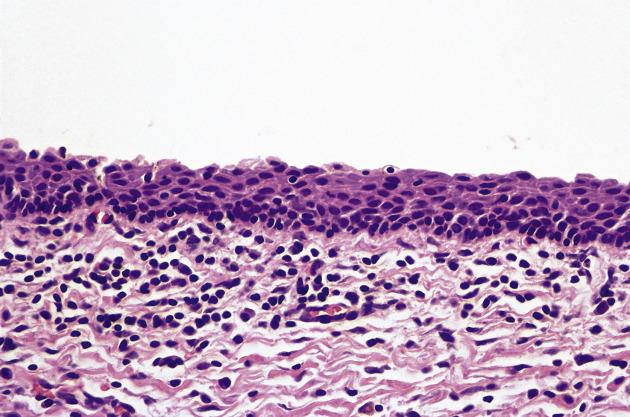
Immature squamous metaplasia can be difficult to distinguish from HSIL, as immature squamous cells may occupy almost the full thickness epithelium, and maturation may only be seen towards the surface. Metaplastic cells have increased N/C ratio which overlaps with that of HSIL; However, there is no crowding or loss of organization, and unlike HSIL, cell membranes are usually well defined. The nuclei are uniform in size and shape, they have fine chromatin, and small nucleoli may be seen. Columnar cells are usually present on the surface overlying the metaplastic epithelium, a feature less commonly seen in HSIL. The term “atypical immature squamous metaplasia” has been described in the literature, but its biology remains obscure and it should not be used for reporting purposes. The degree of nuclear atypia allowed in immature squamous metaplasia is usually less than in HSIL and although mitotic figures may be present, they are not abnormal, as they can be in HSIL. p16 immunohistochemistry has aided in the distinction between benign and intraepithelial lesions previously defined as “atypical immature metaplasia” as it is negative or patchy in atypical immature metaplasia and overexpressed in lesions harboring high-risk HPV.
Transitional metaplasia occurs predominantly in postmenopausal women and it can involve the transformation zone, exocervix, and vagina. It can be confused with HSIL as: (1) this lesion has>10 cell layers; (2) there is absence of squamous maturation; and (3) the nuclei are oval to spindle and have irregular contours. However, in contrast to HSIL, the cells in the superficial layers are oriented horizontally with a streaming pattern, the nuclei are elongated with prominent grooves, there is fine granular chromatin, and mitoses are rare. Rarely, an area of transitional cell metaplasia will show superimposed dysplastic changes.
Florid HSIL with extensive glandular involvement should be distinguished from invasive squamous cell carcinoma . The distinction is not difficult when the endocervical gland is only partially replaced and native endocervical glandular epithelium is appreciated adjacent to HSIL ( Fig. 8.7 ). When HSIL completely replaces and expands endocervical glands, the distinction relies on the presence of a smooth, rounded contour, rather than the irregular, angular configuration of invasive carcinoma. The basement membrane is intact and the surrounding stroma, although sometimes associated with inflammation, does not show desmoplasia ( Fig. 8.8 ). Deeper levels should be routinely considered, since they may reveal a smooth connection with the unequivocal intraepithelial lesion or more overt stromal infiltration pointing towards the correct diagnosis. Occasionally, dysplastic epithelium may be artificially displaced into the stroma during a previous biopsy or surgical procedure, thus mimicking invasive carcinoma ( Fig. 8.12 ). However, the fragmented and distorted appearance of the epithelium is apparent, and the background stroma shows reactive changes including hemorrhage, inflammation, and giant cell reaction. Moreover, the lack of “paradoxical maturation” where the carcinoma cells acquire more abundant, eosinophilic cytoplasm, prominent nucleoli, and well-defined cell borders helps in this distinction ( Fig. 8.13 ).


Although uncommon, epithelioid trophoblastic tumor (ETT) is nonetheless an important differential, as it affects women of reproductive age and frequently replaces surface and crypt endocervical epithelium, thus simulating HSIL. Epithelioid trophoblastic tumors are invariably invasive, and thorough sectioning will reveal more diagnostic areas with expansile growth, necrosis, and nested epithelioid cells surrounded by fibrinoid material. Unlike HSIL, ETT is diffusely positive for cytokeratin 18, inhibin, GATA-3, and HLA-G, and is negative or patchy for p16 by immunohistochemistry. It is important to note that both lesions are p63-positive.
If untreated, HSIL (particularly CIN 3) has a much greater risk of progressing to invasive carcinoma compared to LSIL, ranging from 22% to 72% (studies with the longest follow up have the highest rates of progression to carcinoma). According to the current American Society for Clinical Colposcopists and Pathologists treatment guidelines, the preferred treatment for biopsy-confirmed HSIL is excision of the entire transformation zone, either by laser conization, cold-knife conization, loop electrosurgical excisional procedure (LEEP), or loop electrosurgical conization. The mode of treatment utilized varies depending upon age of the patient, fertility issues, size of the transformation zone, compliance of the patient (risk of loss to follow up), and grade of the lesion (CIN 2 versus CIN 3). Regarding the latter, treatment of CIN 2 lesions is more conservative than CIN 3 in patients 30 years or younger, and women in this group will be spared excision and closely followed.
In most cases, the excised tissue in a conization is received intact and is easy to orient. Electrosurgical excisions, on the other hand, may be received in more than one fragment for the following reasons: (1) the transformation zone is wide and requires two or more passes of the loop for complete excision; or (2) a loop electrosurgical conization is performed, which consists of an exocervical portion and a separate endocervical “top hat.” In these cases, orientation is impossible in the pathology laboratory if the gynecologist has not oriented the specimens previously. If both the endocervical margin and the endocervical curettage (which is performed following excision) are positive for HSIL, the patient may undergo a repeat excisional procedure. Despite a negative endocervical curettage, the presence within the excision of: (1) extensive HSIL involving all four quadrants; (2) positive endocervical margins; and (3) endocervical gland extension are indicative of greater recurrence risk. In such cases, the patient will be followed more closely.
Since many of these specimens are removed using electrocautery, thermal artifact is often present at the margins. Within the thermal zone, there is loss of cellular detail, making margin assessment difficult. However, the zone of thermal artifact should be thin in an electrocautery excision that is performed correctly. If the SIL extends into the zone of cautery upon which ink is visible, the margin should be considered positive. Less frequently, SIL may involve the deep stromal margin within an endocervical gland and, since these patients are also at risk for residual/recurrent disease and subsequent development of invasive carcinoma, they must also be closely followed or have a repeat excision.
Cervical cancer precursor lesion mainly associated with high-risk HPV subtypes
Also known as cervical intraepithelial neoplasia 2 and 3 (CIN 2 and CIN 3)
Up to 31.5 per 100,000 in white Americans and up to 31.2 per 100,000 in black Americans
Up to 0.8% of Papanicolaou tests reported as HSIL
Predominantly located at transformation zone
Significant risk of progression to invasive carcinoma if untreated
Complications of treatment (excision) include cervical incompetence and stenosis
No true racial differences
Peak at 35–39 years, decreasing thereafter
Lately increasing in younger women secondary to changing sexual practices (5% of HSILs diagnosed in women <20 years)
Asymptomatic
Acetowhite epithelium or leukoplakia
Mosaicism, punctations, and atypical vessels secondary to vascular changes
22-72% risk of developing invasive cancer, if untreated
Wide excision of transformation zone
Typically not visible
Occasionally leukoplakia
Loss of maturation and cytologic atypia in all epithelial layers
Syncytial growth (lack of distinct intercellular borders), loss of polarity and nuclear crowding in basal and parabasal layers
Markedly enlarged nuclei (>3 × size of parabasal cell) or multinucleation (≥ five nuclei in single cell)
Immature cells with high N/C ratio, irregular nuclear membrane contour, coarse chromatin, and inconspicuous nucleoli
Superficial layers may show lower N/C ratio and koilocytic change
Frequent mitoses, including atypical forms
CIN 2=atypia involving two lower thirds, with retained maturation
CIN3=atypia involving the entire squamous thickness with loss of maturation
p16 overexpression (continuous strong and diffuse, nuclear and cytoplasmic staining in at least one-third of the epithelial thickness)
Positive nuclear Ki-67 staining in upper two-thirds
Reparative changes
Radiation changes
Atrophy
Immature squamous metaplasia
Transitional metaplasia
LSIL
Invasive squamous cell carcinoma (vs. HSIL with florid glandular involvement)
In contrast to the marked reduction in the incidence of invasive squamous cell carcinoma resulting from effective cervicovaginal screening, the incidence of cervical adenocarcinoma has increased over the last 30 years. In addition, both adenocarcinoma in situ (AIS) and invasive adenocarcinoma are being diagnosed more frequently in women under the age of 35 years. This increase may be partly a result of improved endocervical sampling devices and increased recognition and refinement of criteria to diagnose glandular lesions both cytologically and histologically. The higher frequency of adenocarcinoma in younger women is similar to the trend seen in SIL and is likely a result of changing sexual practices over the years. Nevertheless, AIS is much less common than SIL, with AIS representing only 1% of all high-grade lesions of the cervix.
AIS is a precursor lesion to invasive adenocarcinoma which is supported by several lines of evidence:
There is a temporal relationship between AIS and invasive adenocarcinoma; AIS is diagnosed in women 10–20 years younger than those with invasive adenocarcinoma (mean age of 29–35 years). This age difference is similar to the temporal relationship between SIL and invasive squamous carcinoma.
AIS is frequently found adjacent to invasive adenocarcinoma.
In HPV-related lesions, similar HPV subtypes are identified in both in situ and invasive adenocarcinomas, most frequently HPV 18 (70%), followed by 16 (30%). HPV DNA is present in up to 89% of AIS.
Finally, HSIL or invasive squamous carcinoma has been found in 25%–85% of specimens containing AIS ( Fig. 8.14 ).
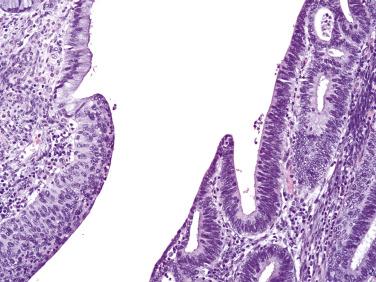
The vast majority of AIS lesions encountered in practice are related to high-risk HPV infection (HPV-related AIS); most of the information in this section pertains to this lesion type. However, other types of AIS unrelated to HPV exist. A prime example is gastric-type AIS, a lesion only recently described after our increased awareness of the existence of gastric-type and other HPV-negative glandular malignancies in the cervix.
AIS is incidentally detected either on a Papanicolaou smear or a colposcopically obtained biopsy, endocervical curettage, or excisional procedure performed during clinical evaluation of SIL. If symptoms are present, the most common is abnormal bleeding.
AIS is difficult to detect by colposcopy, despite the fact that the lesion involves the transformation zone in up to 65% of cases. As AIS does not significantly differ from the normal glandular surface epithelium in terms of thickness, it is difficult to see even with the magnification of a colposcope.
AIS does not produce a grossly visible lesion, often occurs in the transformation zone and is usually unifocal, but through horizontal and lateral spread can involve multiple quadrants.
AIS may involve both the surface epithelium and endocervical glands. As implied by its name, the lesion is confined to the epithelial compartment, and therefore preserves the normal glandular architecture in terms of glandular density, size variation, and distribution through the wall. Comparison with the uninvolved endocervix is most helpful in this assessment. Intraglandular papillae or cribriforming are allowed ( Fig. 8.15A,B ) but should not be extensive. There is often an abrupt transition from neoplastic to normal epithelium in partially involved glands.
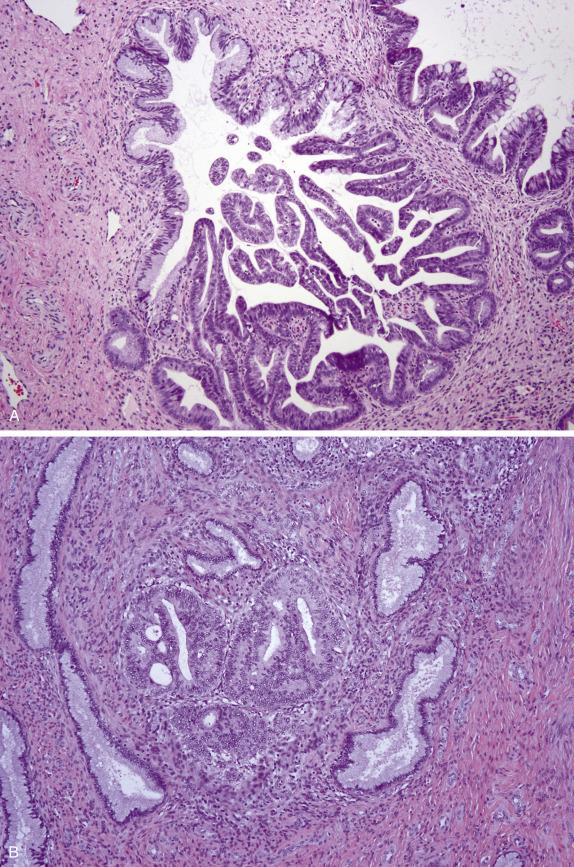
HPV-related AIS is characterized by epithelial crowding and pseudostratification; cells have columnar morphology, and markedly increased N/C ratio with elongated (cigar-shaped), irregular nuclei and coarse chromatin (usually hyperchromatic). Nucleoli are usually inconspicuous but may be multiple. Mitotic figures, particularly in an apical location, are frequent (so-called “floating or suspended mitoses”). Numerous apoptotic bodies are also characteristic ( Fig. 8.15C ). The cytoplasm may be scant and eosinophilic with little or no mucin production, or, less frequently, may display abundant mucin, including intestinal type goblet cells ( Fig. 8.15D ).
When mucin depleted, endocervical glandular lesions have an appearance similar to proliferative endometrium. However, the use of the term “endometrioid” in this setting is not recommended, as this change represents a mimicker rather than true endometrioid differentiation. Instead, these mucin-depleted lesions should be termed “usual type”. Most cases show an admixture of mucin containing and depleted glands. The tubal type of HPV-related AIS is diagnostically challenging because of its similarity to tubal metaplasia, including the presence of cilia and intercalated cells. Nevertheless, the cytologic features of AIS are present, including pseudostratification, nuclear enlargement and elongation, coarse chromatin, mitotic figures, and apoptotic bodies. Another variant of HPV-related AIS is the so-called stratified mucin-producing intraepithelial lesions (SMILE) which shows multiple layers of mucin-containing dysplastic cells populating the entire thickness of the epithelium ( Fig. 8.16 ). The cellular stratification may impart a hybrid appearance of squamous and glandular features, but these lesions represent a variant of AIS as they have a glandular phenotype. Some lesions are true hybrids of glandular and squamous differentiation; when the process has distinct populations of glandular and squamous cells it is best considered adenosquamous carcinoma in situ. Although there is no known difference in behavior amongst the different subtypes, knowledge and recognition of the varying morphologies allows the pathologist to establish the correct diagnosis.
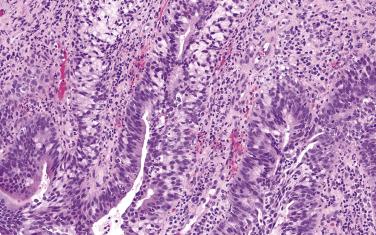
Gastric-type AIS can be seen in association with the atypical form of lobular endocervical glandular hyperplasia (LEGH) (see Chapter 7 ). It is composed of columnar cells with pale to granular eosinophilic cytoplasm, distinct cell borders, and enlarged rounded nuclei with coarse chromatin and distinct nucleoli (different from the mucin-depleted cells with elongated, cigar-shaped and more hyperchromatic nuclei of HPV-related AIS) ( Fig. 8.17 ). Goblet cell differentiation can also be observed ( Fig. 8.18 ).
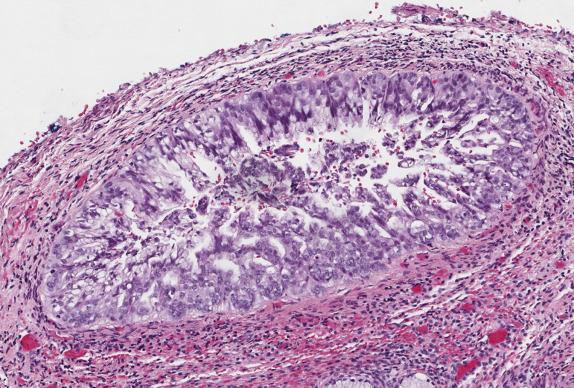

Carcinoembryonic antigen (CEA) is expressed in the cytoplasm of up to 67% of AIS. ER and PR are typically negative or only weakly positive. PAX8 is positive in the vast majority of AIS while PAX2 is negative, distinguishing it from benign endocervical glands, which are uniformly PAX2 positive.
HPV-related AIS will show high Ki-67 index and p16 overexpression (diffuse and strong nuclear and cytoplasmic staining) reflecting its association with high-risk HPV. In contrast, in gastric-type AIS p16 will be negative or patchy. HPV detection studies (in situ hybridization or PCR) can be performed to confirm the diagnosis if necessary (see next section).
AIS should be distinguished from invasive endocervical adenocarcinoma (see later in this chapter), several benign conditions and colonization of endocervical glands by HSIL.
In reactive/reparative atypia , nuclear enlargement, hyperchromasia, and pleomorphism may be present, but the chromatin pattern is smudgy rather than coarse, mitotic figures are rare or absent, apoptotic bodies are not seen, and there is no cellular stratification. Inflammatory cells are present in the stroma adjacent to, and frequently within, the atypical epithelium. In very difficult cases, high Ki-67 index in combination with positive p16 favors AIS over reactive epithelium.
The Arias–Stella reaction may involve endocervical glands of pregnant women or those on hormones. It is identical in appearance to the Arias–Stella reaction within the gravid endometrium. The glands, which may be only partially affected, are lined by pseudostratified glandular epithelium that can form intraluminal papillary structures. There is marked cell enlargement with hyperchromatic and irregular nuclei. A characteristic and useful feature is the presence of hobnail cells. In addition, unlike AIS, the cytoplasm is abundant and vacuolated to clear, and the cells lack nuclear crowding or uniformly atypical nuclei, there are rare to absent mitotic figures, and no apoptotic bodies are found ( Fig. 8.19A ).
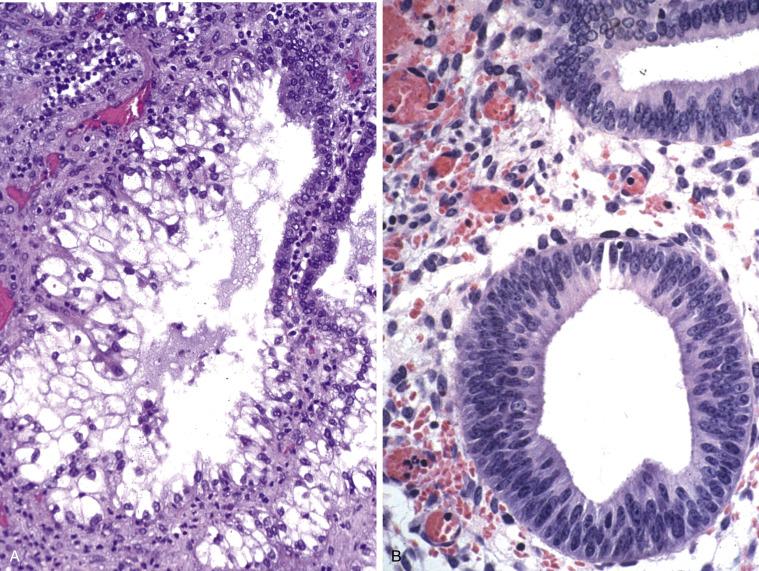
Radiation atypia can show enlarged nuclei and marked nuclear atypia, but the N/C ratio is preserved or reduced and the cytoplasm is often vacuolated. Pseudostratification, apoptotic bodies, and mitotic figures are absent.
Endometriosis can occur in the cervix, not uncommonly following cone biopsy, and frequently shows the characteristic histologic triad of endometrial glands, endometrial-type stroma and recent hemorrhage or hemosiderin-laden macrophages. It is important to recognize the associated endometrial stroma, as the endometrial glands typically have pseudostratified, hyperchromatic, and elongated nuclei that show mitotic activity, thus resembling AIS ( Fig. 8.19B ).
Lower uterine segment (LUS) epithelium can occasionally be difficult to distinguish from AIS in cold-knife cone specimens as it can be pseudostratified with increased N/C ratio. However, the nuclei are usually bland, small and uniform, and mitotic figures are rare.
Tuboendometrioid metaplasia (TEM) is a frequent finding, usually after cone or another cervical procedure. Like AIS, TEM has “mucin depleted” cells with an endometrioid appearance and may display reactive stroma. However, nuclei are uniform and overall retain polarity, and mitotic activity is absent to sparse. Tubal differentiation is consistently seen in this metaplastic process, unlike AIS (which on occasion may display tubal cytomorphology) ( Fig. 8.19C ). TEM is negative for p16 overexpression (but patchy positivity may be seen) and is in turn positive for ER and BCL-2; the opposite profile (p16 overexpressed, negative ER and BCL-2) is expected in AIS.
Cauterized epithelium may show artificial crowding, nuclear elongation, and hyperchromasia, but the degree of elongation is exaggerated and involves both cell nucleus and cytoplasm. No mitotic activity or apoptotic bodies are identified.
Colonization of endocervical glands by HSIL can mimic AIS, in particular SMILE. The presence of mucin and more abundant cytoplasm will be more in keeping with a glandular lesion. Stains for mucicarmine and squamous markers (p63, p40) can aid in this differential.
Similar to SIL, a diagnosis of at least atypical endocervical cells on a Papanicolaou smear should prompt colposcopy. Any visible lesion is biopsied and an endocervical curettage is performed. Following a histologic diagnosis of AIS, the patient undergoes cold-knife conization to evaluate the extent of AIS and exclude invasive adenocarcinoma.
Until recently, the information obtained from a cone biopsy was utilized to plan further surgery. If no invasion was identified on cone biopsy, the patient underwent simple hysterectomy; however, if invasive adenocarcinoma was present, the patient underwent radical hysterectomy. This management strategy is based on several studies that have shown residual disease in up to 30% of women in subsequent hysterectomy specimens despite negative margins on the cone biopsy. However, since many women are delaying child-bearing into the fourth decade, AIS is frequently diagnosed in patients in whom preservation of fertility is important. Even though in these cases cone biopsy may currently be selected as sole therapy, the definitive therapy for AIS remains hysterectomy at present. If conization alone is selected, the lesion must be entirely excised with negative margins. Some patients also undergo sentinel lymph node mapping. Close clinical follow up should be performed with repeat endocervical curettage at defined intervals and consideration for hysterectomy following child-bearing. A LEEP or laser conization is not considered an alternative therapy to cold-knife conization, as there is higher frequency of positive margins (up to 75%) compared to cold-knife conization, where positive margins may be present in up to 24% of cases ( Fig. 8.20 ). Women with positive endocervical margins are at increased risk for having an undiagnosed invasive adenocarcinoma or for developing recurrent AIS.
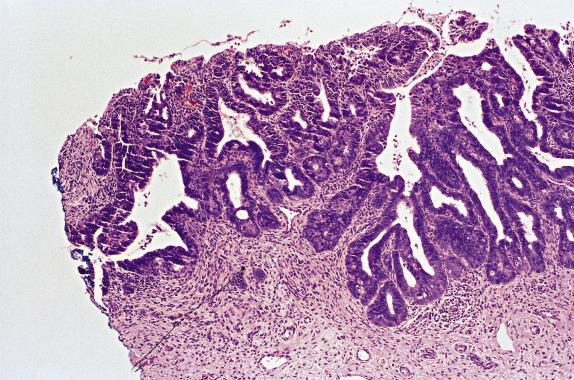
Cervical carcinoma is pathologically staged when detected as a result of screening in the absence of a grossly appreciable lesion. Stage IA is defined by the latest International Collaboration on Cancer Reporting (ICCR) consensus guidelines, incorporated in the latest American Joint Committee on Cancer (AJCC) staging manual and the CAP synoptic reporting protocols, as microscopically identified carcinoma with invasion to a maximum depth of 5 mm and a width no greater than 7 mm ( Table 8.1 ) with further sub-classification into stage IA1 (no greater than 3 mm
Precursor lesion to invasive adenocarcinoma; mainly associated with high-risk HPV, particularly HPV 18
Exact prevalence unknown
Transformation zone, frequently unifocal
Association with HSIL in 24%–75% of cases
If untreated, may progress to invasive adenocarcinoma
No known race predilection
Reproductive-age women (mean age 29 years)
Typically asymptomatic
Rarely abnormal vaginal bleeding
Excellent prognosis, if completely excised
Increased risk of recurrence, if positive margins
Initial treatment includes colposcopy, biopsy of any visible lesion, and endocervical curettage
Cold-knife conization to evaluate extent and exclude invasion, if biopsy proven AIS
Repeat endocervical curettage at defined intervals with consideration for hysterectomy following child-bearing, if fertility desired and cone shows negative margins without invasion
Hysterectomy preferred treatment, if fertility not an issue
No visible lesion
Preservation of normal architecture; glandular density and distribution mirror normal endocervix
Intraglandular papillae or cribriforming may be seen but should not be extensive
HPV-related AIS
Crowded, pseudostratified, columnar cells +/− mucinous cytoplasm
Marked increase in N/C ratio with elongated (cigar-shaped) hyperchromatic and irregular nuclei
Frequent apical mitoses and apoptotic bodies
Variants: tubal and stratified (SMILE)
p16 overexpression and positive for high risk HPV (typically type 18)
Non HPV-related (gastric) AIS
Columnar cells with abundant mucinous cytoplasm (pale to granular eosinophilic) showing prominent cell borders
Enlarged round nuclei with open to heterogeneous chromatin, prominent nucleoli
Cytoplasmic CEA (up to 67%)
High Ki-67 index
ER, PR, vimentin typically negative or weakly/focally positive
PAX8 positive (97%) ranging from strong to weak
PAX2 usually negative
HPV-related AIS: p16 overexpression, positive HPV
Non HPV-related (gastric) AIS: p16 negative or patchy, negative HPV
Reactive/reparative atypia
Arias–Stella reaction
Radiation atypia
Endometriosis
LUS epithelium
TEM
Cautery artifact
Gland involvement by HSIL (versus SMILE)
invasion) and IA2 (between 3 and 5 mm invasion). Importantly, the 2018 International Federation of Gynecology and Obstetrics (FIGO) update no longer requires measurements of horizontal (width) extent ( Table 8.2 ). It is anticipated that this change be reflected in upcoming revisions to ICCR, AJCC, and CAP staging systems. For now, and if needed for synoptic reporting and management purposes, the tumor size measurements can be best assessed following the ICCR consensus guidelines. Depth of invasion and width are measured on the single slide that displays the deepest and/or widest extent of invasion. Since this only results in an estimate of the area (i.e., a 2-dimensional measurement), it is necessary to provide a third measurement to estimate the volume of (i.e., the circumferential growth around the cervix). This is achieved, though imprecisely in most cases, by providing the percentage of circumference involvement and the number of consecutive sections containing contiguous foci of invasive carcinoma ( Fig. 8.21 ). When 3 or more consecutive sections (with an average thickness of 2–4 mm) contain invasive tumor, it is likely that the volume of invasive carcinoma exceeds the size criteria for superficially invasive carcinoma (stage IA1). In many centers, these patients are upstaged to Stage IA2 or IB1. If the tumor is grossly visible, the lesion is stage IB regardless of size ( Table 8.1 ).
| Primary tumor (T) | |
|
Primary tumor cannot be assessed |
|
No evidence of primary tumor |
|
Carcinoma in situ |
|
Carcinoma confined to uterus (extension to corpus should be disregarded) |
|
Invasive carcinoma diagnosed only by microscopy. Stromal invasion with a maximum depth of 5.0 mm measured from the base of the epithelium and a horizontal spread of 7.0 mm or less. Vascular space involvement, venous or lymphatic, does not affect classification |
|
Clinical visible lesion confined to the cervix or microscopic lesion greater than T1a |
|
Carcinoma invades beyond uterus but not to pelvic wall or to lower third of vagina |
|
Tumor without parametrial invasion |
|
Tumor with parametrial invasion |
|
Tumor extends to pelvic wall and/or involves lower third of vagina, and/or causes hydronephrosis or nonfunctioning kidney |
|
Tumor involves lower third of vagina |
|
Tumor extends to pelvic wall and/or causes hydronephrosis or nonfunctioning kidney |
|
Tumor invades mucosa of bladder or rectum, and/or extends beyond true pelvis |
| Regional lymph nodes (N) | |
|
Regional lymph nodes cannot be assessed |
|
No regional lymph node metastasis |
|
Regional lymph node metastasis |
| Distant metastasis (M) | |
|
Distant metastasis cannot be assessed |
|
No distant metastasis |
|
Distant metastasis |
| I | The carcinoma is strictly confined to the cervix (extension to the uterine corpus should be disregarded) |
| IA | Invasive carcinoma that can be diagnosed only by microscopy, with maximum depth of invasion <5 mm |
| IA1 | Measured stromal invasion <3 mm in depth |
| IA2 | Measured stromal invasion ≥3 mm and <5 mm in depth |
| IB | Clinically visible tumor, or microscopic invasive carcinoma with measured deepest invasion ≥5 mm (greater than Stage IA), lesion limited to the cervix uteri |
| IB1 | Invasive carcinoma ≥5 mm depth of stromal invasion, and <2 cm in greatest dimension |
| IB2 | Invasive carcinoma ≥2 cm and <4 cm in greatest dimension |
| IB3 | Invasive carcinoma ≥4 cm in greatest dimension |
| II | The carcinoma invades beyond the uterus, but has not extended onto the lower third of the vagina or to the pelvic wall |
| IIA | Involvement limited to the upper two-thirds of the vagina without parametrial involvement |
| IIA1 | Invasive carcinoma <4 cm in greatest dimension |
| IIA2 | Invasive carcinoma ≥4 cm in greatest dimension |
| IIB | With parametrial involvement but not up to the pelvic wall |
| III | The carcinoma involves the lower third of the vagina and/or extends to the pelvic wall and/or causes hydronephrosis or nonfunctioning kidney and/or involves pelvic and/or paraaortic lymph nodes |
| IIIA | The carcinoma involves the lower third of the vagina, with no extension to the pelvic wall |
| IIIB | Extension to the pelvic wall and/or hydronephrosis or nonfunctioning kidney (unless known to be due to another cause) |
| IIIC | Involvement of pelvic and/or paraaortic lymph nodes, irrespective of tumor size and extent (with r and p notations) |
| IIIC1 | Pelvic lymph node metastasis only |
| IIIC2 | Paraaortic lymph node metastasis |
| IV | The carcinoma has extended beyond the true pelvis or has involved (biopsy proven) the mucosa of the bladder or rectum. (Bullous edema, as such, does not permit a case to be allotted to Stage IV) |
| IVA | Spread to adjacent pelvic organs |
| IVB | Spread to distant organs |
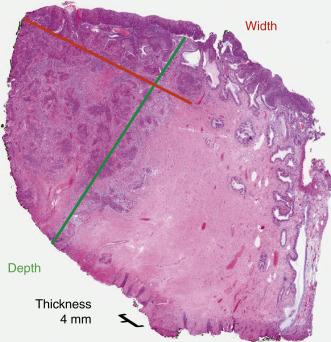
The depth of stromal invasion should be measured from the base of the closest epithelial compartment, either the surface or gland crypts (usually involved by HSIL or AIS), to the deepest edge of invasive carcinoma. Measurement of invasive depth and width requires that the section is adequately oriented, and that the intraepithelial and invasive components are easily discernible. Unfortunately, this is not always possible, particularly in biopsy and LEEP material and in the setting of endocervical adenocarcinoma (see later in this chapter). In instances of uncertainty, the following approaches can be considered:
When tumor extends to margin, estimate size in terms of “invasive tumor measures at least …”
When clear distinction between in situ and invasive carcinoma is not possible, estimate size in terms of “in situ and invasive carcinoma measure…” In this situation, report the distance between the surface and the deepest extent of invasion (including in situ and invasive carcinoma) instead of providing a potentially misleading “depth of invasion”.
In superficial, nonoriented and inadequately embedded biopsy material, defer tumor size measurement to further excisional material (cone or hysterectomy).
Although lymphovascular invasion does not alter stage, its presence should be always recorded.
Multifocality does not affect the stage in cervical carcinoma, but its presence should be reported in LEEP and cone specimens as it may be an indicator of more extensive residual disease. Two areas of invasive carcinoma can be confidently regarded as separate foci if: a) there is normal cervical mucosa or clearly spaced zones of HSIL or AIS in between (preferably more than 2 mm), or b) they are in two different, noncontiguous tissue blocks/sections ( Fig. 8.22 ). All other instances, in general, are best interpreted as unifocal disease. With multifocal disease, the horizontal extent and depth of invasion of each focus should be provided, and the stage should be based on the largest individual horizontal and depth measurements.
According to AJCC/FIGO staging systems, carcinoma confined to the cervix is staged based on tumor size
Clinically/grossly visible tumors are stage IB.
Nonvisible lesions require tumor extent measurement microscopically:
In addition to width and depth, the circumferential extent should be estimated by recording the number of consecutive tissue slices involved by tumor (>3 slices likely exceeds width criteria for stage IA1 carcinoma).
Depth of invasion is measured from base of closest epithelial compartment (surface or nearest gland) to deepest point of invasive tumor
Invasive carcinoma measurement is frequently difficult in adenocarcinoma and in small, tangentially sectioned tissues
Carcinoma is multifocal if there is at least 2 mm of normal tissue, well-spaced HSIL/AIS or uninvolved tissue blocks in between foci of invasion.
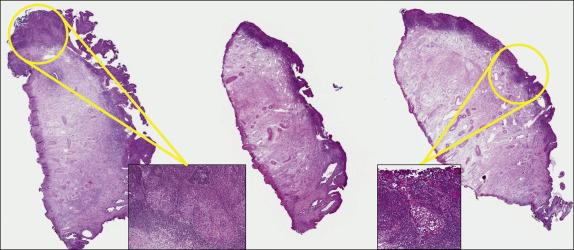
Squamous cell carcinoma (SCC) is the third most common cancer in women worldwide following breast and colorectal cancer. In developing countries, squamous cell carcinoma of the cervix is the second most common cancer in women. In the United States, cervical carcinoma follows endometrial and ovarian carcinomas in prevalence in the female genital tract, and accounts for approximately 4100 deaths each year (2.3 deaths/100,000 women). Squamous cell carcinoma is the most common type of carcinoma of the cervix. Although previously accounting for >90% of all cervical cancers, the overall frequency has decreased due to the implementation and success of national cervical cytology screening programs. This has also resulted in the detection of otherwise asymptomatic small, early invasive lesions, which offers the possibility of conservative management due to the negligible (but not absent) risk of metastases.
Invasive squamous cell carcinoma accounts for approximately 13% of all newly diagnosed gynecologic cancers and 0.8% of newly diagnosed cancers overall, and it is responsible for 13% of all deaths from genital tract cancers in women in the United States. This disease affects adult women, mostly during perimenopause and reproductive life. Importantly, 25% of stage IB tumors occur in women <40 years and 5% in women ≤30 years, impacting not only the survival and quality of life but also the fertility of these patients. However, the incidence has declined with the implementation of widespread cervical screening programs. In fact, in countries with modern health care systems, the majority of patients with early invasive carcinoma present with an abnormal Papanicoalou test. Grossly evident carcinoma presents with postcoital or intermenstrual bleeding. Growth into parametria and involvement of ureters, obstructive uropathy and renal failure herald the natural course of untreated cervical cancer. Pain is usually indicative of pelvic wall or lumbosacral nerve root invasion. In advanced stages, hematuria, rectal bleeding, or constipation may indicate bladder or rectal involvement.
Superficially invasive carcinoma, by definition, does not form a grossly visible tumor.
Small macroscopically identifiable invasive carcinoma of the cervix appears as a raised, red, granular lesion on colposcopic exam. More advanced tumors tend to be exophytic, involve the ectocervix, and thus, are clinically apparent with speculum examination. Tumors confined to the endocervical canal are more commonly endophytic, resulting in a barrel-shaped expansion of the cervix.
Squamous cell carcinoma may either present as an exophytic friable polypoid or papillary tumor (more frequently in the exocervix) ( Fig. 8.23 ), as an ulcerative lesion, or as a nodular, ulcerated, endophytic mass (more frequently involving the endocervix) with extensive infiltration of the cervical wall resulting in a barrel-shaped configuration.
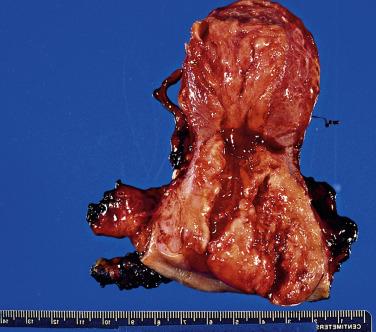
From the architectural perspective, invasive squamous cell carcinoma is seen as:
Small and irregularly contoured nests of malignant cells detached from HSIL. The invasive foci frequently appear more differentiated than those of the adjacent precursor lesion, with abundant eosinophilic cytoplasm and sometimes keratinization (so-called paradoxical maturation). A useful diagnostic clue to early invasion is the presence of accompanying desmoplastic stroma, edema, and marked chronic inflammation ( Fig. 8.24A,B ).
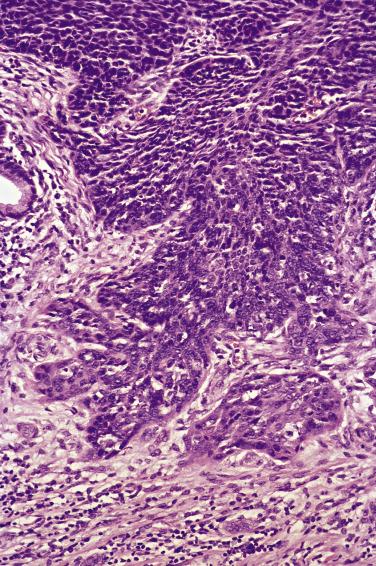
Anastomosing cords, nests and islands with irregular size and shapes ( Fig. 8.25A,B ).
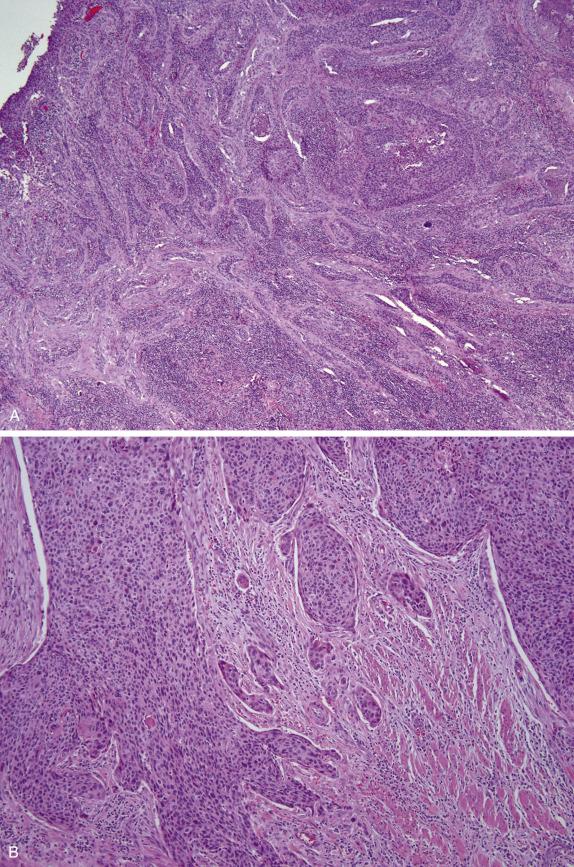
The cells are oval to polygonal, often with eosinophilic cytoplasm, cell borders are usually sharp but may be indistinct, and intercellular bridges may be apparent. The nuclei display considerable pleomorphism, with coarse and granular chromatin. Mitoses are common, with frequent atypical forms. The desmoplastic stroma present in some tumors may be heavily infiltrated by inflammatory cells, with eosinophils or lymphocytes often predominating ( Fig. 8.25C ).
Overall, grading squamous cell carcinomas of the cervix lacks clinical value. Nevertheless, the following system may be used:
Well-differentiated (grade 1): mature squamous cells with abundant keratin pearl formation and intercellular bridges, mostly in large cohesive nests.
Moderately differentiated (grade 2): cells with less cytoplasm, less distinct cell borders, higher pleomorphism and mitoses, arranged in groups of varying sizes that include small clusters and even individual cells. Approximately 60% of squamous cell carcinomas belong to this group.
Poorly differentiated (grade 3): primitive-appearing small cells with scant cytoplasm and hyper chromatic nuclei with increased mitoses, showing diffuse stromal infiltration with a solid, sheet-like appearance and prominent single-cell infiltration.
Squamous cell carcinoma can be keratinizing or nonkeratinizing, though the amount of keratin formation necessary to make that distinction is not well defined. Keratinizing squamous cell carcinoma contains squamous pearls, keratohyaline granules or dense cytoplasmic keratinization. They may arise in a background of keratinizing HSIL and have coarse smudgy chromatin; nucleoli may not be prominent. The presence of keratinization does not necessarily place a tumor in the well-differentiated category. Nonkeratinizing areas of the tumor have polygonal cells growing in sheets and nests. The nuclei are large with coarse chromatin and nucleoli are usually visible. The N/C ratio may be high.
Become a Clinical Tree membership for Full access and enjoy Unlimited articles
If you are a member. Log in here